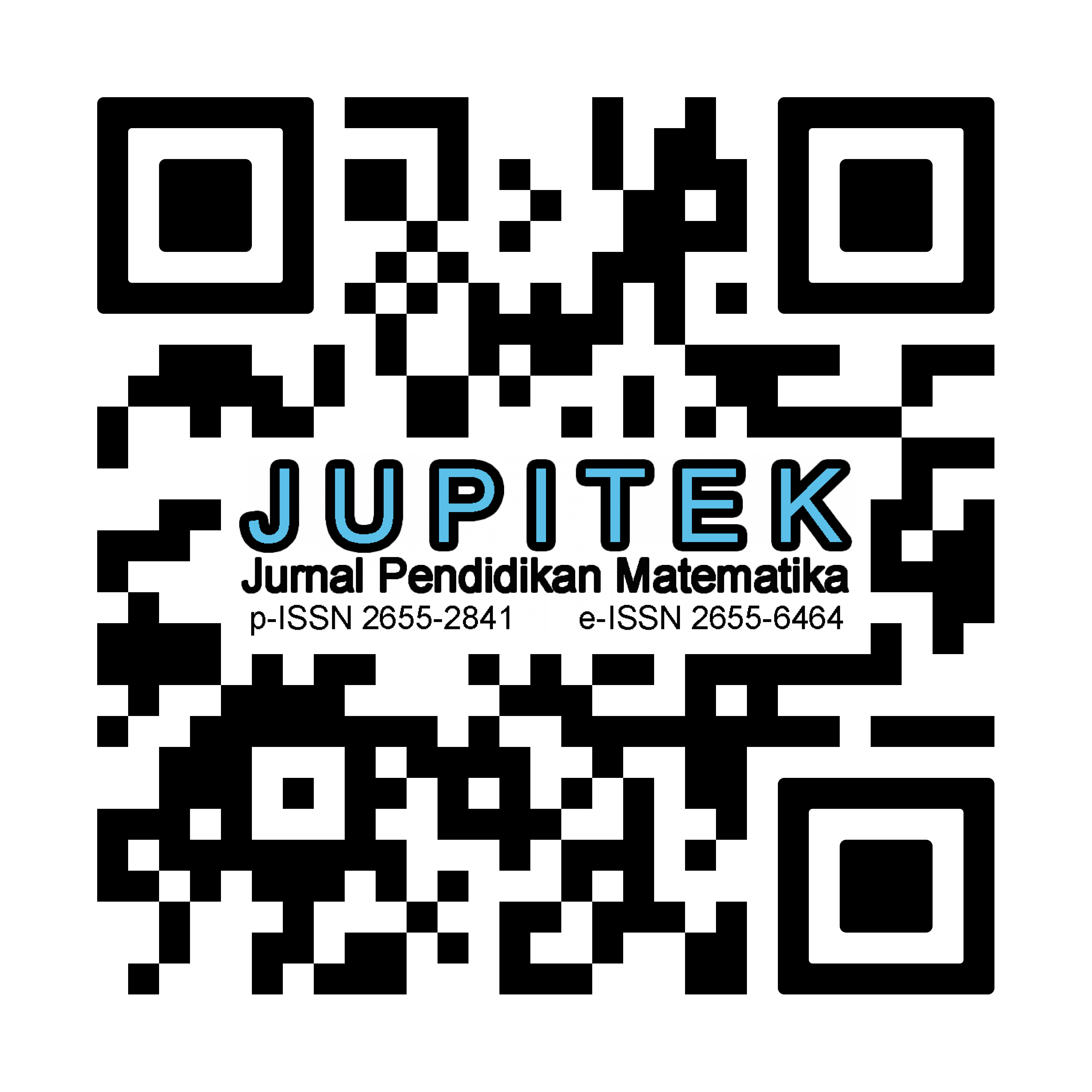STUDENTS' MATHEMATICAL LITERACY IN SOLVING PROBLEMS SYSTEM OF EQUATION OF THREE VARIABLES
Abstract
The main focus in this study aims to analyze the mathematical literacy skills of students at senior high school in solving problems involving the system of linear equations of three variables. The researcher took a qualitative descriptive method. The research subjects were 34 students from class X8. Problem sheets and interviews were the main data collection methods in this study. Researchers reduced data, presented data, and drew conclusions to handle data using a triangulation approach. The indicators of mathematical literacy skills studied were 1) Communication; 2) Mathematization; 3) Strategies in problem solving; 4) Use of language and symbolic operations; formal and technical; 5) Reasoning and argumentation skills. The findings of this study revealed that only one indicator, the communication indicator, was mastered by students in the low mathematical literacy category. Three indicators, namely communication indicators, problem solving techniques and mathematical communication indicators, can be mastered by students with medium mathematical literacy. Students with high mathematical literacy were able to understand and use each sign correctly. Students at SMA Negeri 1 Slogohimo have an average percentage of low mathematical literacy ability of 21%, medium mathematical literacy ability of 18%, and high mathematical literacy ability of 61%
Downloads
References
Aldila Afriansyah, E., Herman, T., Turmudi, & Afgani Dahlan, J. (2021). Critical Thinking Skills In Mathematics. Journal of Physics: Conference Series, 1778(1). https://doi.org/10.1088/1742-6596/1778/1/012013
Andari, R. M., & Setianingsih, R. (2021). Students’ Mathematical Literacy in Solving PISA Problem Using Indonesian Cultural Context. JRPM (Jurnal Review Pembelajaran Matematika), 6(1), 52–67. https://doi.org/10.15642/jrpm.2021.6.1.52-67
Apriandi, D., Murtafiah, W., Ayuningtyas, A. D., Widjajanti, D. B., Prabawati, M., & Herman, T. (2019). Analysis of mathematical literacy skills and mathematics self-efficacy of junior high school students Analysis of mathematical literacy skills and mathematics self- efficacy of junior high school students. Journal of Physics: Conference Series, 1320(1), 0–6. https://doi.org/10.1088/1742-6596/1320/1/012053
Dewi, S. P., & Kartini, K. (2021). Analisis Kesalahan Siswa Dalam Menyelesaikan Soal Sistem Persamaan Linear Tiga Variabel Berdasarkan Prosedur Kesalahan Newman. Jurnal Cendekia : Jurnal Pendidikan Matematika, 5(1), 632–642. https://doi.org/10.31004/cendekia.v5i1.508
Farida, R. N., Qohar, A., & Rahardjo, S. (2021). Analisis Kemampuan Literasi Matematis Siswa SMA Kelas X Dalam Menyelesaikan Soal Tipe Pisa Konten Change and Relationship. Jurnal Cendikia : Jurnal Pendidikan Matematika, 05(03), 2802–2815. https://doi.org/10.31004/cendekia.v5i3.972
Kurniawan, H. S., & Khotimah, R. P. (2022). Profil Kemampuan Literasi Matematis Siswa Dalam Menyelesaiakan Soal High Order Thinking Skill. AKSIOMA : JUrnal Program Studi Pendidikan Matematika, 11(3), 1966–1977. https://doi.org/10.24127/ajpm.v11i3.5563
Kuswanti, Y., & Nusantara, T. (2018). Deskripsi Kesalahan Siswa pada Penyelesaian Masalah Sistem Persamaan Linear Tiga Variabel (SPLTV). Jurnal Pendidikan : Teori, Penelitian, Dan Pengembangan, 3(1980), 865–872. https://doi.org/10.17977/jptpp.v3i7.11286
Murtiyasa, B., Rahma, W., & Perwita, G. (2020). Analysis of Mathematics Literation Ability of Students in Completing PISA-Oriented Mathematics Problems with Changes and Relationships Content. Universal Journal of Educational Research, 8(7), 3160–3172. https://doi.org/10.13189/ujer.2020.080745
Nurutami, A., Riyadi, R., & Subanti, S. (2018). The Analysis of Studentsr Mathematical Literacy Based on Mathematical Ability. In Mathematics, Informatics, Science, and Education International Conference (MISEIC 2018), 157(Miseic), 162–166. https://doi.org/10.2991/miseic-18.2018.40
OECD. (2017). Pisa 2015 Assesment And Analytical Framework: Science, Reading, Mathematic, Financial Literacy And Collaborative Problem Solving, Revised Edition. OECD Publishing.
Oki, S., Iskandar, R. S. F., & Andri Nur Triyanto, L. (2021). Analisis Kemampuan Literasi Matematis Siswa Kelas Viii Dengan Soal Pisa. Gammath : Jurnal Ilmiah Program Studi Pendidikan Matematika, 6(1), 291–300. https://doi.org/10.32528/gammath.v6i1.5398
Rusmining. (2017). Analysis of Mathematics Literacy of Students of Mathematics Education Department Analisis Kemampuan Literasi Matematika Mahasiswa Pendidikan Matematika Ditinjau Info Artikel Abstrak. Unnes Journal Of Mathematics Education, 6(3), 384–390. https://doi.org/10.15294/ujme.v6i3.19518
Setiani, C., Waluya, S. B., & Wardono. (2018). Analysis of mathematical literacy ability based on self-efficacy in model eliciting activities using metaphorical thinking approach. Journal of Physics: Conference Series, 983(1), 0–7. https://doi.org/10.1088/1742-6596/983/1/012139
Stacey, K., & Turner, R. (2015). Assessing Mathematical Literacy. In Assessing Mathematical Literacy. https://doi.org/10.1007/978-3-319-10121-7
Sumardi, W. N. A. (2022). Analisis Tingkat Literasi Matematika Siswa Dalam Menyelesaiakan Soal Sistem Persamaan Linear Dua Variabel. AKSIOMA: Jurnal Program Studi Pendidikan MatematIika, 11(2), 1453–1461. https://doi.org/10.24127/ajpm.v11i2.4951
Yanisa, S. Y., Sujiarto, H., & Hakim, L. L. (2022). Analisis Kemampuan Literasi Matematis Peserta Didik SMP Berdasarkan Self-Efficacy melalui Strategi Brain Based Learning. Prisma, 11(2), 526. https://doi.org/10.35194/jp.v11i2.2500
Yanti, I., Asiani, R. W., & Kukuh, M. (2022). Students’ Mathematical Literacy in Solving Higher Order Thinking Skill Problems on Matrix Material. Jurnal Pendidikan Matematika (JUPITEK), 5(2), 175–186. https://doi.org/10.30598/jupitekvol5iss2pp175-186
Yasmita, D. (2018). Upaya Meningkatkan Hasil Belajar Matematika Materi Perkalian Dan Pembagian Bilangan Dengan Menggunakan Lembaran Latihan Terbimbing. Jurnal Ilmu Pendidikan Sosial, Sains Dan Humaniora, 4(1), 137–158. https://doi.org/10.24014/suara%20guru.v4i1.5596
Yulia, Y., Kustati, M., & Afriadi, J. (2021). Mathematical Literacy: A Case Study on Padang Students’ Mathematical Ability. Al-Jabar : Jurnal Pendidikan Matematika, 12(1), 109–120. https://doi.org/10.24042/ajpm.v12i1.8538.

Copyright (c) 2023 Melisa Melisa, Nida Sri Utama

This work is licensed under a Creative Commons Attribution-NonCommercial-ShareAlike 4.0 International License.
License and Copyright Agreement
By submitting a manuscript to Jurnal Pendidikan Matematika (JUPITEK), the author(s) certify and agree to the following terms:
- Originality and Authority: The submitting author is authorized by all co-authors to enter into this agreement. The manuscript describes original work that has not been published previously in a peer-reviewed journal, nor is it under consideration for publication elsewhere.
- Approval: Its publication has been approved by all author(s) and by the responsible authorities of the institutions where the work was carried out.
- Rights: The authors secure the right to reproduce any material that has already been published or copyrighted elsewhere.
- Licensing and Copyright: Authors retain the copyright to their work.
- License Grant: The authors grant Jurnal Pendidikan Matematika (JUPITEK) the right of first publication, with the work simultaneously licensed under the Creative Commons Attribution-NonCommercial-ShareAlike 4.0 International (CC BY-NC-SA 4.0).
- Self-Archiving: Authors are permitted and encouraged to deposit the published version of their article in institutional repositories, on their personal websites, and other academic platforms, with proper acknowledgment of its initial publication in Jurnal Pendidikan Matematika (JUPITEK).





.png)


